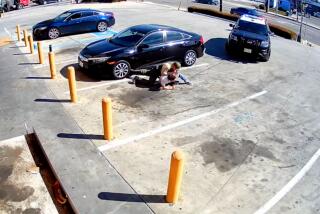Sheriff Bars Deputies From ‘Hogtying’ Suspects
- Share via
The Los Angeles County Sheriff’s Department, facing criticism of its treatment of suspects, has changed its policy to prohibit a controversial form of restraint known by critics as hogtying.
The decision comes as a lawyer--who filed a wrongful-death suit against the massive law enforcement agency--released a Sheriff’s Department videotape showing deputies in the Athens area using the restraint on a suspect who died shortly after his hands and feet were tied behind his back.
“The timing on this is coincidental,” said department spokesman Doyle Campbell. “The policy has been under review for quite a while. It was decided that we would end up not tying suspects behind their back but control them by tying them in front. It works just as well with less risk.”
The practice--also referred to as hobbling and officially known in Sheriff’s Department parlance as TARP, for Total Appendage Restraint Procedure--typically has been used against combative suspects, some of whom are intoxicated and difficult to control.
In the Athens incident, deputies arrested Dwayne Nelson, 41, on suspicion of being under the influence of cocaine after responding to a report that someone was firing at passing motorists. After Nelson was handcuffed and put in the back of a patrol car, he reportedly started kicking the windows. That prompted deputies to restrain him.
Attorney Leo Terrell, who is representing Nelson’s mother, this week played for reporters a videotape showing a handcuffed Nelson face down and surrounded by at least four deputies. The tape--which was recorded by sheriff’s deputies--shows Nelson grunting and screaming as deputies cinched the line around both feet and hands. In the tape, one deputy can be seen with both of his knees on Nelson’s back while others tie his legs and hands with a nylon strap.
Nelson’s screams turned to moans before he fell silent. Deputies then turned him over and were unable to get a response from him. A deputy began doing chest compressions while another attempted to administer CPR through a tube while Nelson lay on his back with his hands cuffed beneath him. He was later pronounced dead at Centinela Hospital.
A department investigation found that the deputies’ actions conformed to Sheriff’s Department policy.
An autopsy found that Nelson had died of a preexisting heart condition, a finding that Terrell said he will challenge with testimony from an independent pathologist.
“The officers killed him,” he said. “This man was not going to die but for the officers’ conduct. Precious seconds were lost between the time of turning him over and beginning CPR.”
Terrell said Nelson had not harmed himself when the deputies stopped their squad car to further restrain him using the controversial technique. The attorney has photos taken after Nelson’s death showing what he calls small, superficial cuts.
“There was never an allegation that the deputies were in danger,” Terrell said. “This should never have happened.”
Terrell said the Los Angeles Police Department training manual clearly indicates that there is a danger of asphyxiation when hogtying is used on someone lying face-down. That danger was increased, he said, when the deputy put his knees on Nelson’s back.
Other agencies, including the LAPD, have concluded that the danger of asphyxiation is increased even more if a person is under the influence of drugs, as deputies suspected Nelson was.
Two years ago, the LAPD decided to ban the controversial restraint practice after the city paid $750,000 to settle a wrongful-death lawsuit filed by the family of a Sunland man who died after hobbling was used on him in 1995.
An LAPD training bulletin in September 1997 warned: “Due to the dangers of positional asphyxia, [the restraint method] shall not be used to bind an individual’s hand to his/her feet in any manner.”
In the wake of the LAPD’s policy change, the Sheriff’s Department began reviewing its restraint procedures about 21 months ago, said Lt. Mike McDermott, who works in the sheriff’s training bureau. After receiving approval from department officials and union representatives, changes in the restraint procedures were put in place earlier this week. Training tapes were being distributed Thursday showing deputies how to perform the new procedure.
Under the new policy, deputies are required to restrain violent suspects by tying them up in a sitting position.
“Until the medical field is able to explain to us what causes sudden cardiac arrest, we have to come up with any piece of technology we can to secure subjects in a safe way,” McDermott said. “I think the [new method] is going to work better. Absolutely.”
Attorney Merrick Bobb, who oversees the department as special counsel to the Board of Supervisors, applauded the department’s policy change.
“I strongly approve experimentation with nonlethal uses of force to determine the safest way to restrain a suspect while at the same time not compromising the safety of the police officer,” Bobb said. “I’m very interested in whether this alternative restraint method proves to be an effective and safe option.”
More to Read
Sign up for Essential California
The most important California stories and recommendations in your inbox every morning.
You may occasionally receive promotional content from the Los Angeles Times.













